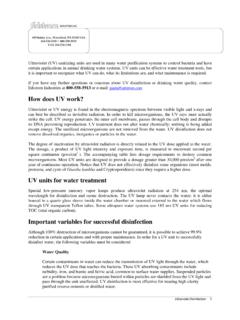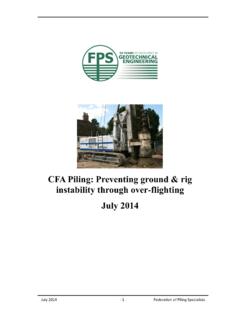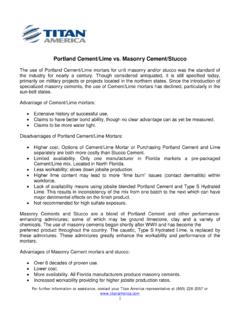Transcription of Efflorescence: Cause and Control
1 efflorescence : Cause and Control1 ef-jlo-res-cence (ef' le res 'ens), 1. a change on the surface to a powdery substance upon exposure to air, as a crystalline substance through loss of water . 2. to become incrusted or covered with crystals of salt or the like through evaporation or chemical change. efflorescence is the stubborn problem that has caused confusion and trouble for masonry since the first time it appeared thousands of years ago on ancient masonry walls. efflorescence is normally the white, powdery scum that can appear on masonry walls after construction but can also be brown green or yellow, depending on the type of salts. Nobody likes it, nobody wants it on their walls, but occasionally this persistent problem appears. Great deals of time, money and effort have been spent trying to solve the difficulties efflorescence generates. Many test programs have been developed and numerous attempts have been made to eliminate the efflorescence problem. Unfortunately, nothing has proven 100% effective against this very stubborn problem.
2 However, even though no surefire cure has been discovered, a great deal has been learned about how efflorescence works and how to prevent it, and if preventive measures are inadequate, how to remove the efflorescence if it does appear. This article explains the mechanics of white efflorescence , how to help prevent efflorescence and some traditional methods used to remove efflorescence from new walls. What is efflorescence ? We know that efflorescence is a fine, white, powdery deposit of water -soluble salts left on the surface of masonry as the water evaporates. These efflorescent salt deposits tend to appear at the worst times, usually about a month after the building is constructed, and sometimes as long as a year after completion. Required Conditions: efflorescence is not a simple subject. Three conditions must exist before efflorescence will occur.. t First: There must be water -soluble salts present somewhere in the wall. Second: There must be sufficient moisture in the wall to render the salts into a soluble solution.
3 Third: There must be a path for the soluble salts to migrate through to the surface where the moisture can evaporate, thus depositing the salts which then crystallize and Cause efflorescence . All three conditions must exist. If any one of these conditions is not present, then efflorescence cannot occur. Even though the efflorescence problem is complex, it is not difficult to prevent. Although no economically feasible way exists to totally eliminate any one of these three conditions, it is quite simple to reduce all three and make it nearly impossible for efflorescence to occur. Source of Efflorescent Salts A chemical analysis of efflorescent salts in the Southern California area (1) reveals that they are principally alkalies of Sodium Sulfates (Na3S04) and Potassium Sulfates (K2S04). These are the main soluble salts to be concerned with in Southern California since these are 90% of the efflorescence found in this area. These alkali sulfates appear because they exist somewhere within the masonry wall, either in the brick, the mortar, or the grout, or possibly a combination of these three.
4 These alkalies combine with sulfates from the masonry to form sulfate salts. The alkali sulfates in the wall are dissolved by water into a solution which then moves through the natural pores in the masonry. The solution migrates to the surface of the wall where the water evaporates, depositing the salts on the wall and generating the white powdery scum we know as efflorescence . Figure 1. Typical white efflorescent salts on brick and block masonry 1 Based on a technical paper written by Michael Merrigan, , originally published in The Masonry Society Journal, January-June, 1986 Figure 2. Possible path of water soluble salts that form efflorescence Research into each of the materials used in masonry walls reveals that the main source of alkalies for the salts is the Portland cements used in the mortar and grout. Using a low alkali Portland cement will often eliminate the efflorescent problem. It is recommended that low alkali Portland cement be used to reduce the chances of efflorescence occurring.
5 Low alkali Portland cement has alkali or less, by weight in the cement (2, 3). Another culprit is, of course, the clay brick itself. The natural clays used in the manufacture of brick often contain soluble alkali sulfates. Most modern fired clay brick have balanced chemical additives, such as Barium Carbonate (BaCO3), to immobilize the sulfates and render them insoluble (4). This prevents the salts from being dissolved into a solution that could migrate through the wall to the surface. Most fired clay brick do not greatly contribute towards the efflorescence problem. The next source for soluble salts would be the sand used in the mortar and grout. Contaminated sands with soluble alkali sulfates will Cause efflorescence unless the sulfates are removed. Using clean, washed sand will eliminate any efflorescing contribution.
6 The water used in the mortar and grout during construction can also be a source of contaminants. Clean, potable, salt free water must be used at all times. Tests of Colorado River tap water show only insignificant amounts of salts in the water . water from other sources should be checked for their alkali sulfate contents to be sure no efflorescing salts will be introduced into the masonry wall. In the past, hydrated lime used in the mortar was thought to have been responsible for efflorescence . This did make sense to the layperson. After all, anyone can make a logical connection between the white lime and the white efflorescent salts. However, chemical analysis and experimental tests proved otherwise. Hydrated lime (Ca(OH)2) does not contribute sufficiently towards the soluble alkali sulfates necessary for efflorescence to occur (generally only 1/4 to 1/10 the efflorescing potential of the cements).
7 In addition, the hydrated limes also reduce the voids in the mortar, thus reducing the area for capillary flow of any solutions in the wall. Potential efflorescent problems can be greatly reduced by using low alkali cements, clean washed sands and clean, potable salt free water . Controlling efflorescence Even if soluble alkali sulfates exist in a masonry wall, before the sulfates can Cause efflorescence the salts must be dissolved into solution by water . If no moisture reaches the sulfates then they cannot be rendered into solution and migrate to the surface where the water will evaporate, leaving the sulfate salts on the surface to crystallize and become efflorescence . Attention must be given to preventing any soluble alkaline sulfates from being rendered into solution by water . This is difficult since during construction water is naturally used in the mortar and grout, therefore the amount of water in the wall should be controlled to only that amount necessary for actual construction.
8 The majority of the water is absorbed into the masonry and used to chemically react with the Portland cement and hydrated lime and is thus not free water . The next critical concern is to prevent any water from penetrating into the masonry wall where it could Cause efflorescence to occur. This can be done with good architectural details and quality masonry construction. Designing with overhanging eaves, copings and flashings, and careful attention to landscaping and sprinklers will reduce the chances of water entering the wall. In addition, specifying tooled, compacted mortar joints (concave or "V" type) will also reduce the potential for water infiltration. See Figures 3 and 4 for good efflorescence controlling design. As mentioned earlier, for efflorescence to appear, the alkali sulfates must be able to travel through the pores in the masonry to the surface.
9 If the natural pores in the wall can be reduced, it becomes harder for the salts to migrate through to the surface. Consolidating the grout with mechanical vibration will greatly reduce any voids in the grout, as well as improving the bond of the steel and the masonry wall. Dense tooled mortar joints will also reduce the porous nature of the wall and make it difficult for the salts to migrate. Grout admixtures that claim to inhibit efflorescence can also be used. These chemical additives claim to improve the flow of the grout mix while decreasing the water content. They also claim to reduce voids in the grout due to shrinkage. Special care must be taken when using these grout admixtures. Individual manufacturers have developed them and their actual contents are protected trade secrets. The manufacturer's recommendations must be closely followed. 2 Figure 3. Overhanging eaves will help greatly to prevent moisture from entering this stack bond CMU wall.
10 Figure 4. A full metal coping helps in waterproofing a wall and eliminates moisture penetration through the tops of parapets .To summarize, three conditions must exist before efflorescence can occur. If these three conditions can be controlled, there should be no efflorescing of masonry walls. 1. Reduce all soluble alkali sulfates. 2. Use good details to prevent water from entering the masonry. 3. Use good construction practices to eliminate migratory paths for moisture. Remember, it is very difficult to totally Control any one of these three conditions, but it is relatively simple to reduce the effect each one has towards efflorescence . Removing efflorescence Despite all efforts, efflorescence may sometimes occur. A detail may have been omitted. Materials may have been incorrectly specified or may not have been used as specified. Sometimes conditions just naturally conspire to generate efflorescence on a wall.








